Work Life Balance
VerifiedAdded on 2023/06/08
|14
|3663
|159
AI Summary
This report discusses the concept of work life balance and its diverse benefits for employees and organizations. It explores the theories related to work life balance, issues faced by organizations, and management strategies to address work-life conflicts. It also provides examples of work-life balance in Australia.
Contribute Materials
Your contribution can guide someone’s learning journey. Share your
documents today.
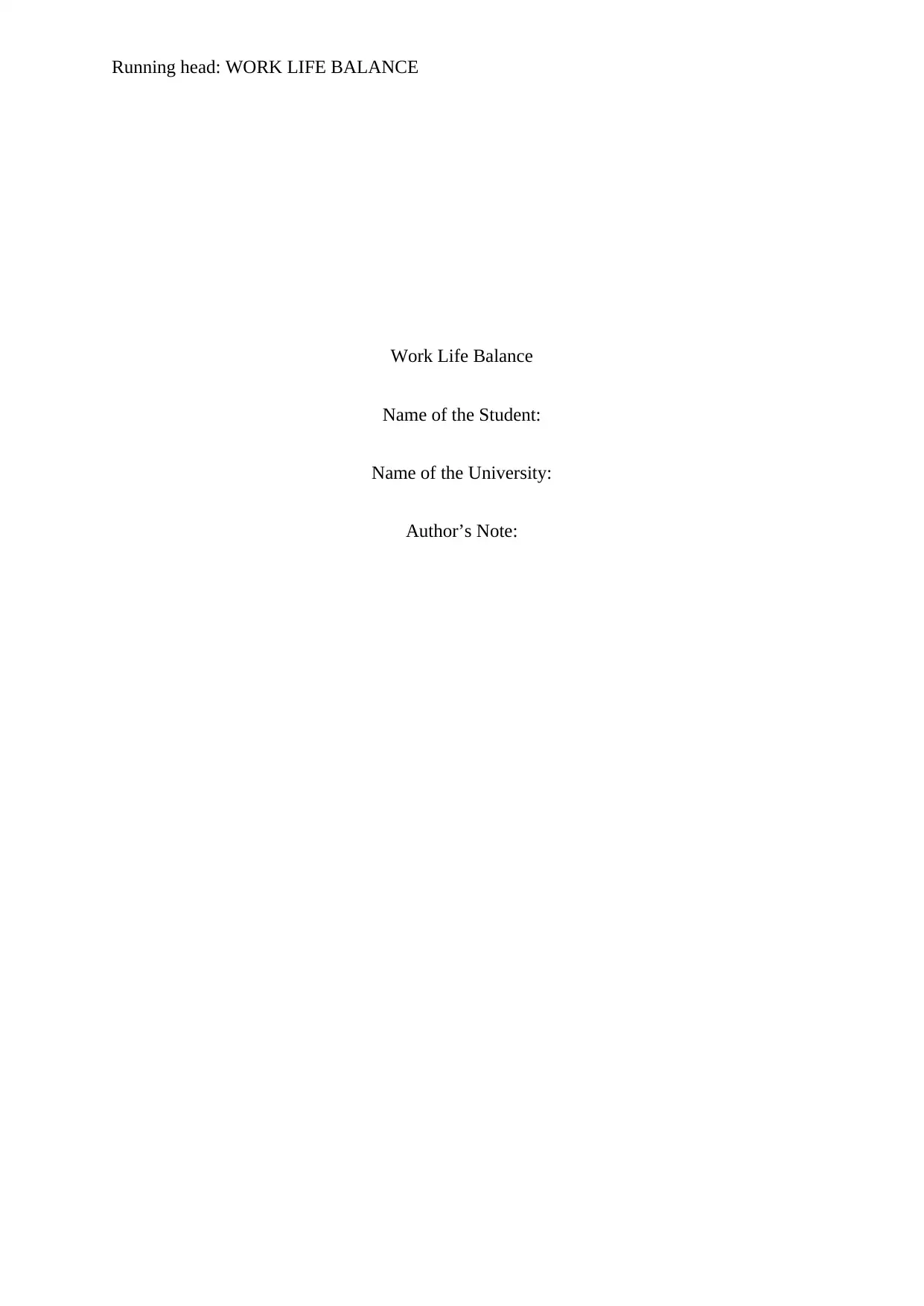
Running head: WORK LIFE BALANCE
Work Life Balance
Name of the Student:
Name of the University:
Author’s Note:
Work Life Balance
Name of the Student:
Name of the University:
Author’s Note:
Secure Best Marks with AI Grader
Need help grading? Try our AI Grader for instant feedback on your assignments.
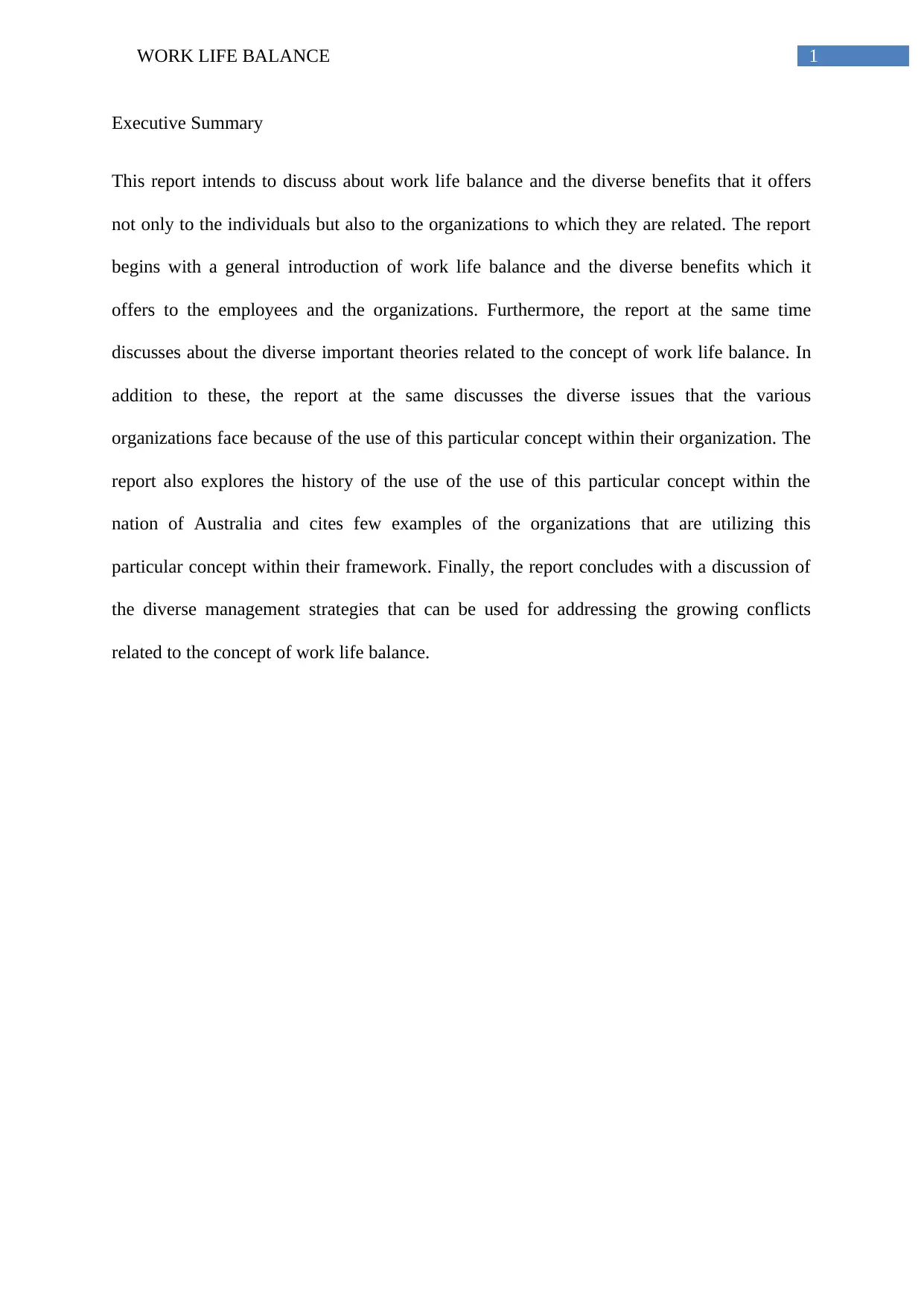
1WORK LIFE BALANCE
Executive Summary
This report intends to discuss about work life balance and the diverse benefits that it offers
not only to the individuals but also to the organizations to which they are related. The report
begins with a general introduction of work life balance and the diverse benefits which it
offers to the employees and the organizations. Furthermore, the report at the same time
discusses about the diverse important theories related to the concept of work life balance. In
addition to these, the report at the same discusses the diverse issues that the various
organizations face because of the use of this particular concept within their organization. The
report also explores the history of the use of the use of this particular concept within the
nation of Australia and cites few examples of the organizations that are utilizing this
particular concept within their framework. Finally, the report concludes with a discussion of
the diverse management strategies that can be used for addressing the growing conflicts
related to the concept of work life balance.
Executive Summary
This report intends to discuss about work life balance and the diverse benefits that it offers
not only to the individuals but also to the organizations to which they are related. The report
begins with a general introduction of work life balance and the diverse benefits which it
offers to the employees and the organizations. Furthermore, the report at the same time
discusses about the diverse important theories related to the concept of work life balance. In
addition to these, the report at the same discusses the diverse issues that the various
organizations face because of the use of this particular concept within their organization. The
report also explores the history of the use of the use of this particular concept within the
nation of Australia and cites few examples of the organizations that are utilizing this
particular concept within their framework. Finally, the report concludes with a discussion of
the diverse management strategies that can be used for addressing the growing conflicts
related to the concept of work life balance.
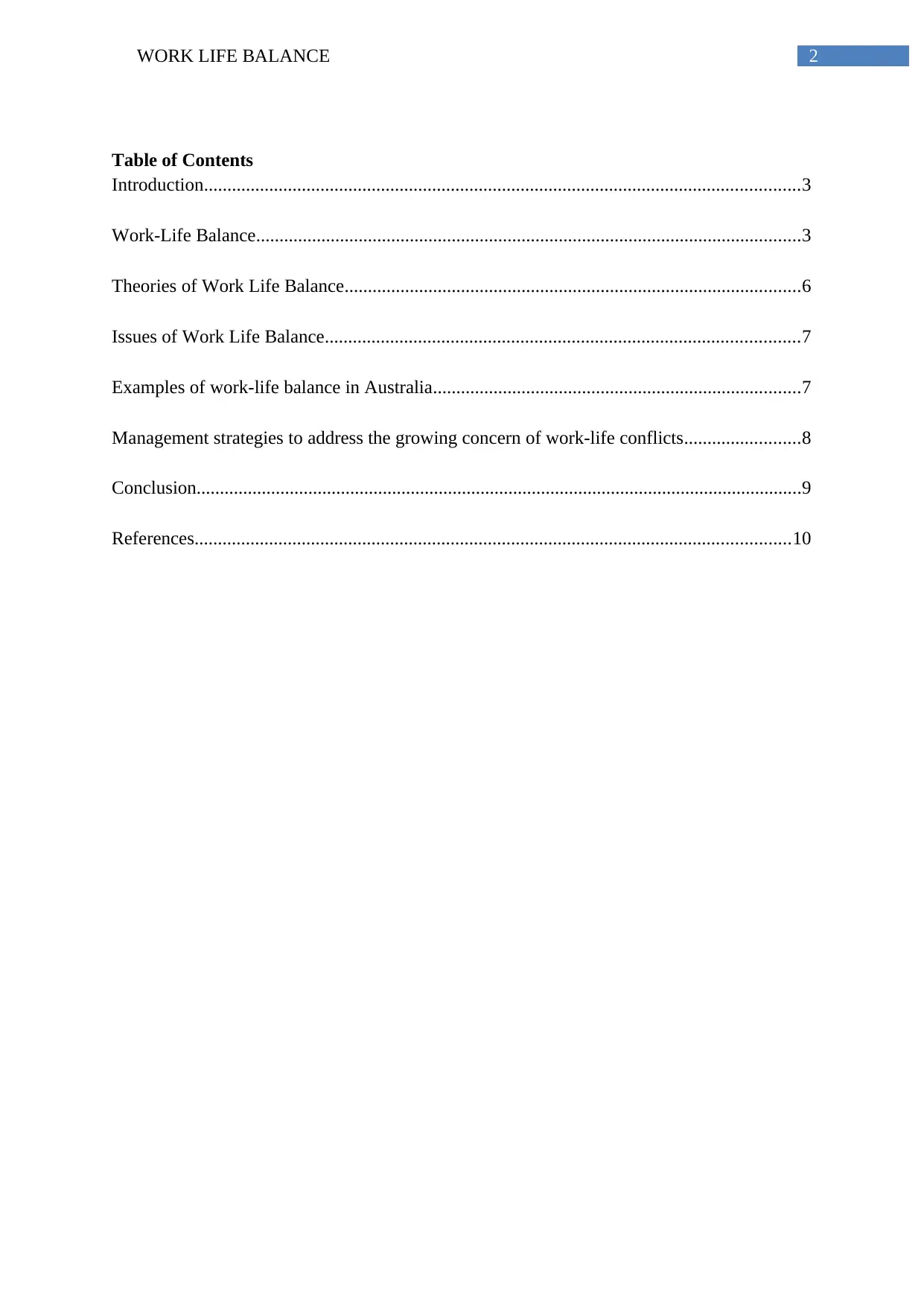
2WORK LIFE BALANCE
Table of Contents
Introduction................................................................................................................................3
Work-Life Balance.....................................................................................................................3
Theories of Work Life Balance..................................................................................................6
Issues of Work Life Balance......................................................................................................7
Examples of work-life balance in Australia...............................................................................7
Management strategies to address the growing concern of work-life conflicts.........................8
Conclusion..................................................................................................................................9
References................................................................................................................................10
Table of Contents
Introduction................................................................................................................................3
Work-Life Balance.....................................................................................................................3
Theories of Work Life Balance..................................................................................................6
Issues of Work Life Balance......................................................................................................7
Examples of work-life balance in Australia...............................................................................7
Management strategies to address the growing concern of work-life conflicts.........................8
Conclusion..................................................................................................................................9
References................................................................................................................................10
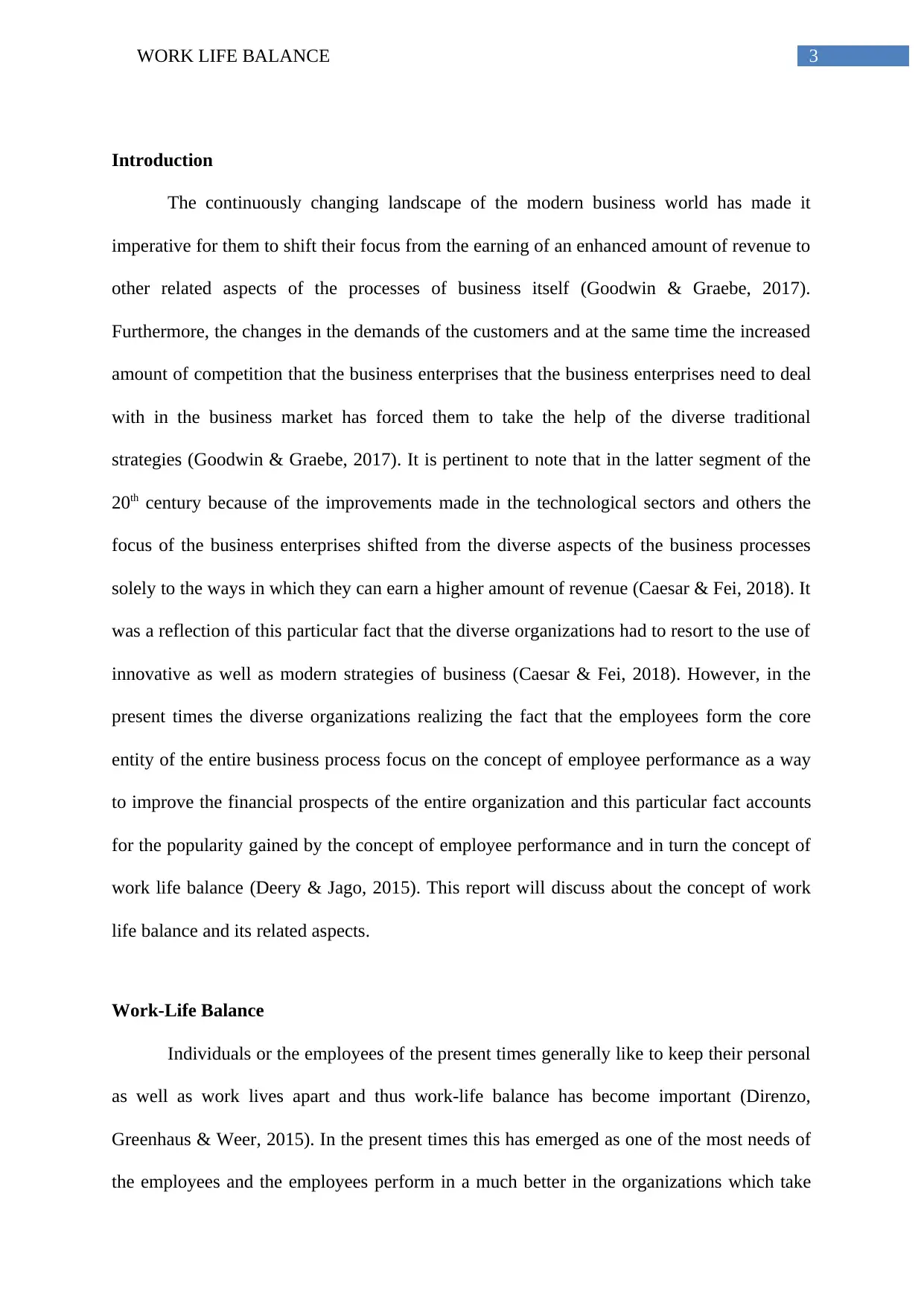
3WORK LIFE BALANCE
Introduction
The continuously changing landscape of the modern business world has made it
imperative for them to shift their focus from the earning of an enhanced amount of revenue to
other related aspects of the processes of business itself (Goodwin & Graebe, 2017).
Furthermore, the changes in the demands of the customers and at the same time the increased
amount of competition that the business enterprises that the business enterprises need to deal
with in the business market has forced them to take the help of the diverse traditional
strategies (Goodwin & Graebe, 2017). It is pertinent to note that in the latter segment of the
20th century because of the improvements made in the technological sectors and others the
focus of the business enterprises shifted from the diverse aspects of the business processes
solely to the ways in which they can earn a higher amount of revenue (Caesar & Fei, 2018). It
was a reflection of this particular fact that the diverse organizations had to resort to the use of
innovative as well as modern strategies of business (Caesar & Fei, 2018). However, in the
present times the diverse organizations realizing the fact that the employees form the core
entity of the entire business process focus on the concept of employee performance as a way
to improve the financial prospects of the entire organization and this particular fact accounts
for the popularity gained by the concept of employee performance and in turn the concept of
work life balance (Deery & Jago, 2015). This report will discuss about the concept of work
life balance and its related aspects.
Work-Life Balance
Individuals or the employees of the present times generally like to keep their personal
as well as work lives apart and thus work-life balance has become important (Direnzo,
Greenhaus & Weer, 2015). In the present times this has emerged as one of the most needs of
the employees and the employees perform in a much better in the organizations which take
Introduction
The continuously changing landscape of the modern business world has made it
imperative for them to shift their focus from the earning of an enhanced amount of revenue to
other related aspects of the processes of business itself (Goodwin & Graebe, 2017).
Furthermore, the changes in the demands of the customers and at the same time the increased
amount of competition that the business enterprises that the business enterprises need to deal
with in the business market has forced them to take the help of the diverse traditional
strategies (Goodwin & Graebe, 2017). It is pertinent to note that in the latter segment of the
20th century because of the improvements made in the technological sectors and others the
focus of the business enterprises shifted from the diverse aspects of the business processes
solely to the ways in which they can earn a higher amount of revenue (Caesar & Fei, 2018). It
was a reflection of this particular fact that the diverse organizations had to resort to the use of
innovative as well as modern strategies of business (Caesar & Fei, 2018). However, in the
present times the diverse organizations realizing the fact that the employees form the core
entity of the entire business process focus on the concept of employee performance as a way
to improve the financial prospects of the entire organization and this particular fact accounts
for the popularity gained by the concept of employee performance and in turn the concept of
work life balance (Deery & Jago, 2015). This report will discuss about the concept of work
life balance and its related aspects.
Work-Life Balance
Individuals or the employees of the present times generally like to keep their personal
as well as work lives apart and thus work-life balance has become important (Direnzo,
Greenhaus & Weer, 2015). In the present times this has emerged as one of the most needs of
the employees and the employees perform in a much better in the organizations which take
Secure Best Marks with AI Grader
Need help grading? Try our AI Grader for instant feedback on your assignments.
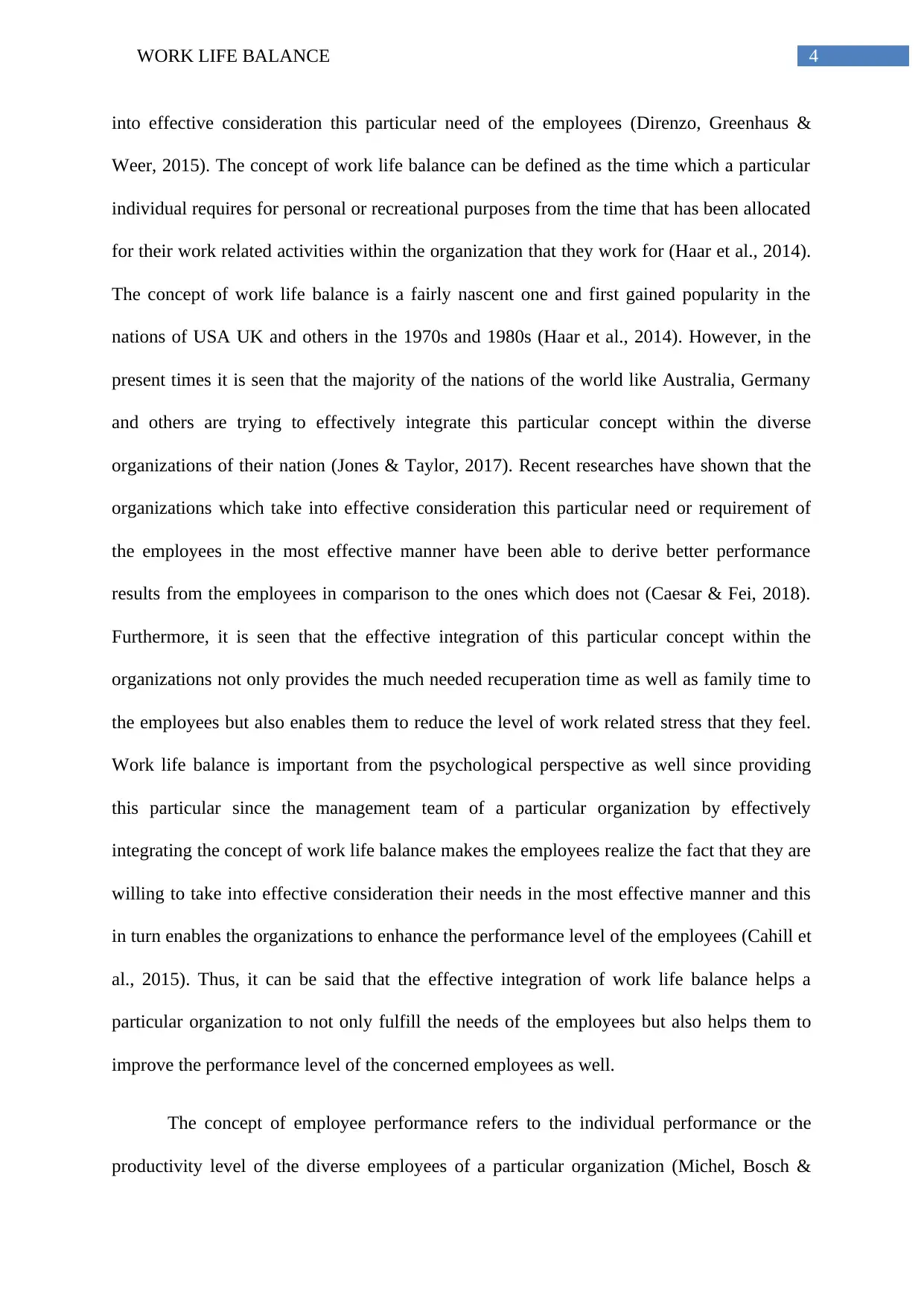
4WORK LIFE BALANCE
into effective consideration this particular need of the employees (Direnzo, Greenhaus &
Weer, 2015). The concept of work life balance can be defined as the time which a particular
individual requires for personal or recreational purposes from the time that has been allocated
for their work related activities within the organization that they work for (Haar et al., 2014).
The concept of work life balance is a fairly nascent one and first gained popularity in the
nations of USA UK and others in the 1970s and 1980s (Haar et al., 2014). However, in the
present times it is seen that the majority of the nations of the world like Australia, Germany
and others are trying to effectively integrate this particular concept within the diverse
organizations of their nation (Jones & Taylor, 2017). Recent researches have shown that the
organizations which take into effective consideration this particular need or requirement of
the employees in the most effective manner have been able to derive better performance
results from the employees in comparison to the ones which does not (Caesar & Fei, 2018).
Furthermore, it is seen that the effective integration of this particular concept within the
organizations not only provides the much needed recuperation time as well as family time to
the employees but also enables them to reduce the level of work related stress that they feel.
Work life balance is important from the psychological perspective as well since providing
this particular since the management team of a particular organization by effectively
integrating the concept of work life balance makes the employees realize the fact that they are
willing to take into effective consideration their needs in the most effective manner and this
in turn enables the organizations to enhance the performance level of the employees (Cahill et
al., 2015). Thus, it can be said that the effective integration of work life balance helps a
particular organization to not only fulfill the needs of the employees but also helps them to
improve the performance level of the concerned employees as well.
The concept of employee performance refers to the individual performance or the
productivity level of the diverse employees of a particular organization (Michel, Bosch &
into effective consideration this particular need of the employees (Direnzo, Greenhaus &
Weer, 2015). The concept of work life balance can be defined as the time which a particular
individual requires for personal or recreational purposes from the time that has been allocated
for their work related activities within the organization that they work for (Haar et al., 2014).
The concept of work life balance is a fairly nascent one and first gained popularity in the
nations of USA UK and others in the 1970s and 1980s (Haar et al., 2014). However, in the
present times it is seen that the majority of the nations of the world like Australia, Germany
and others are trying to effectively integrate this particular concept within the diverse
organizations of their nation (Jones & Taylor, 2017). Recent researches have shown that the
organizations which take into effective consideration this particular need or requirement of
the employees in the most effective manner have been able to derive better performance
results from the employees in comparison to the ones which does not (Caesar & Fei, 2018).
Furthermore, it is seen that the effective integration of this particular concept within the
organizations not only provides the much needed recuperation time as well as family time to
the employees but also enables them to reduce the level of work related stress that they feel.
Work life balance is important from the psychological perspective as well since providing
this particular since the management team of a particular organization by effectively
integrating the concept of work life balance makes the employees realize the fact that they are
willing to take into effective consideration their needs in the most effective manner and this
in turn enables the organizations to enhance the performance level of the employees (Cahill et
al., 2015). Thus, it can be said that the effective integration of work life balance helps a
particular organization to not only fulfill the needs of the employees but also helps them to
improve the performance level of the concerned employees as well.
The concept of employee performance refers to the individual performance or the
productivity level of the diverse employees of a particular organization (Michel, Bosch &
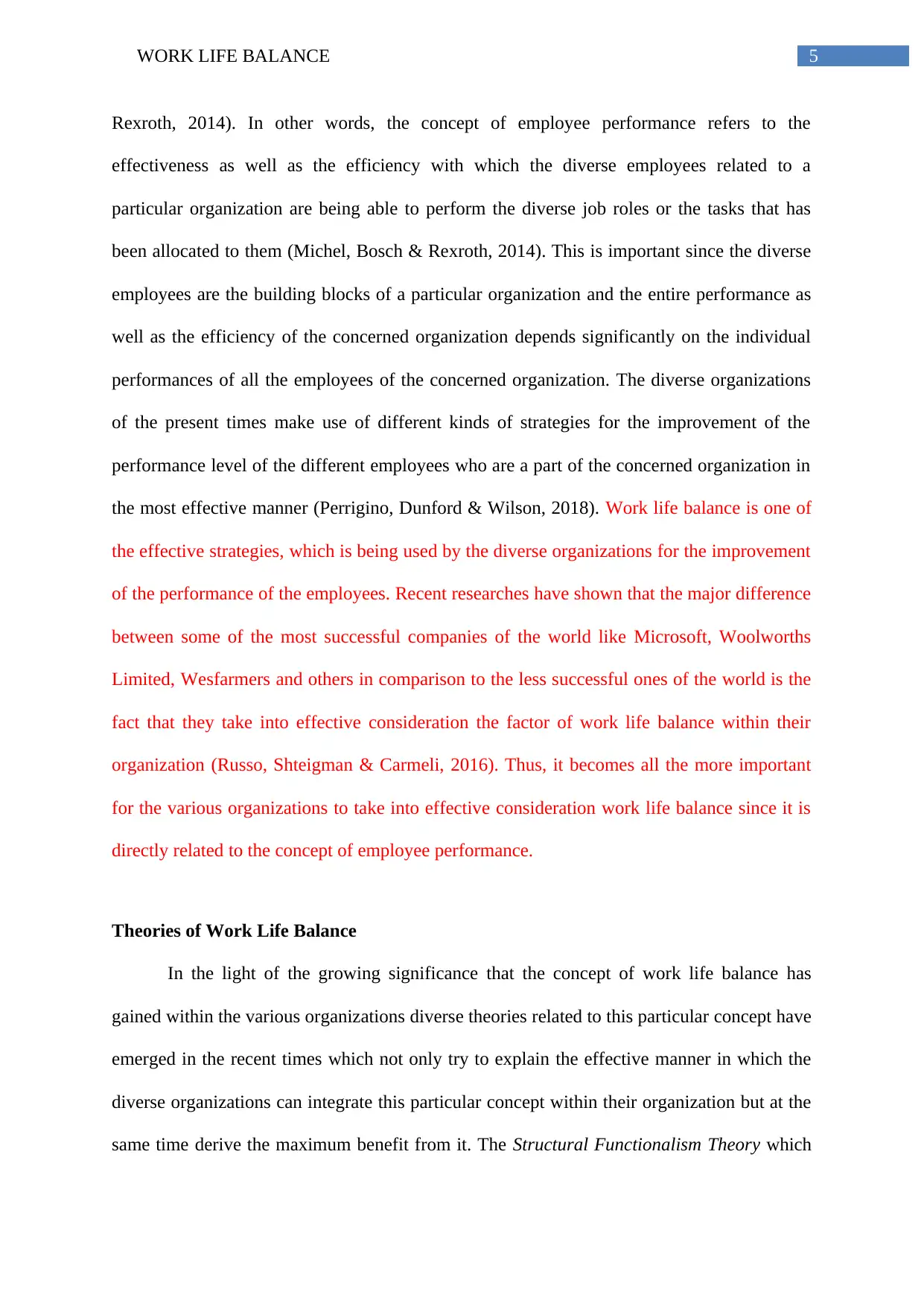
5WORK LIFE BALANCE
Rexroth, 2014). In other words, the concept of employee performance refers to the
effectiveness as well as the efficiency with which the diverse employees related to a
particular organization are being able to perform the diverse job roles or the tasks that has
been allocated to them (Michel, Bosch & Rexroth, 2014). This is important since the diverse
employees are the building blocks of a particular organization and the entire performance as
well as the efficiency of the concerned organization depends significantly on the individual
performances of all the employees of the concerned organization. The diverse organizations
of the present times make use of different kinds of strategies for the improvement of the
performance level of the different employees who are a part of the concerned organization in
the most effective manner (Perrigino, Dunford & Wilson, 2018). Work life balance is one of
the effective strategies, which is being used by the diverse organizations for the improvement
of the performance of the employees. Recent researches have shown that the major difference
between some of the most successful companies of the world like Microsoft, Woolworths
Limited, Wesfarmers and others in comparison to the less successful ones of the world is the
fact that they take into effective consideration the factor of work life balance within their
organization (Russo, Shteigman & Carmeli, 2016). Thus, it becomes all the more important
for the various organizations to take into effective consideration work life balance since it is
directly related to the concept of employee performance.
Theories of Work Life Balance
In the light of the growing significance that the concept of work life balance has
gained within the various organizations diverse theories related to this particular concept have
emerged in the recent times which not only try to explain the effective manner in which the
diverse organizations can integrate this particular concept within their organization but at the
same time derive the maximum benefit from it. The Structural Functionalism Theory which
Rexroth, 2014). In other words, the concept of employee performance refers to the
effectiveness as well as the efficiency with which the diverse employees related to a
particular organization are being able to perform the diverse job roles or the tasks that has
been allocated to them (Michel, Bosch & Rexroth, 2014). This is important since the diverse
employees are the building blocks of a particular organization and the entire performance as
well as the efficiency of the concerned organization depends significantly on the individual
performances of all the employees of the concerned organization. The diverse organizations
of the present times make use of different kinds of strategies for the improvement of the
performance level of the different employees who are a part of the concerned organization in
the most effective manner (Perrigino, Dunford & Wilson, 2018). Work life balance is one of
the effective strategies, which is being used by the diverse organizations for the improvement
of the performance of the employees. Recent researches have shown that the major difference
between some of the most successful companies of the world like Microsoft, Woolworths
Limited, Wesfarmers and others in comparison to the less successful ones of the world is the
fact that they take into effective consideration the factor of work life balance within their
organization (Russo, Shteigman & Carmeli, 2016). Thus, it becomes all the more important
for the various organizations to take into effective consideration work life balance since it is
directly related to the concept of employee performance.
Theories of Work Life Balance
In the light of the growing significance that the concept of work life balance has
gained within the various organizations diverse theories related to this particular concept have
emerged in the recent times which not only try to explain the effective manner in which the
diverse organizations can integrate this particular concept within their organization but at the
same time derive the maximum benefit from it. The Structural Functionalism Theory which
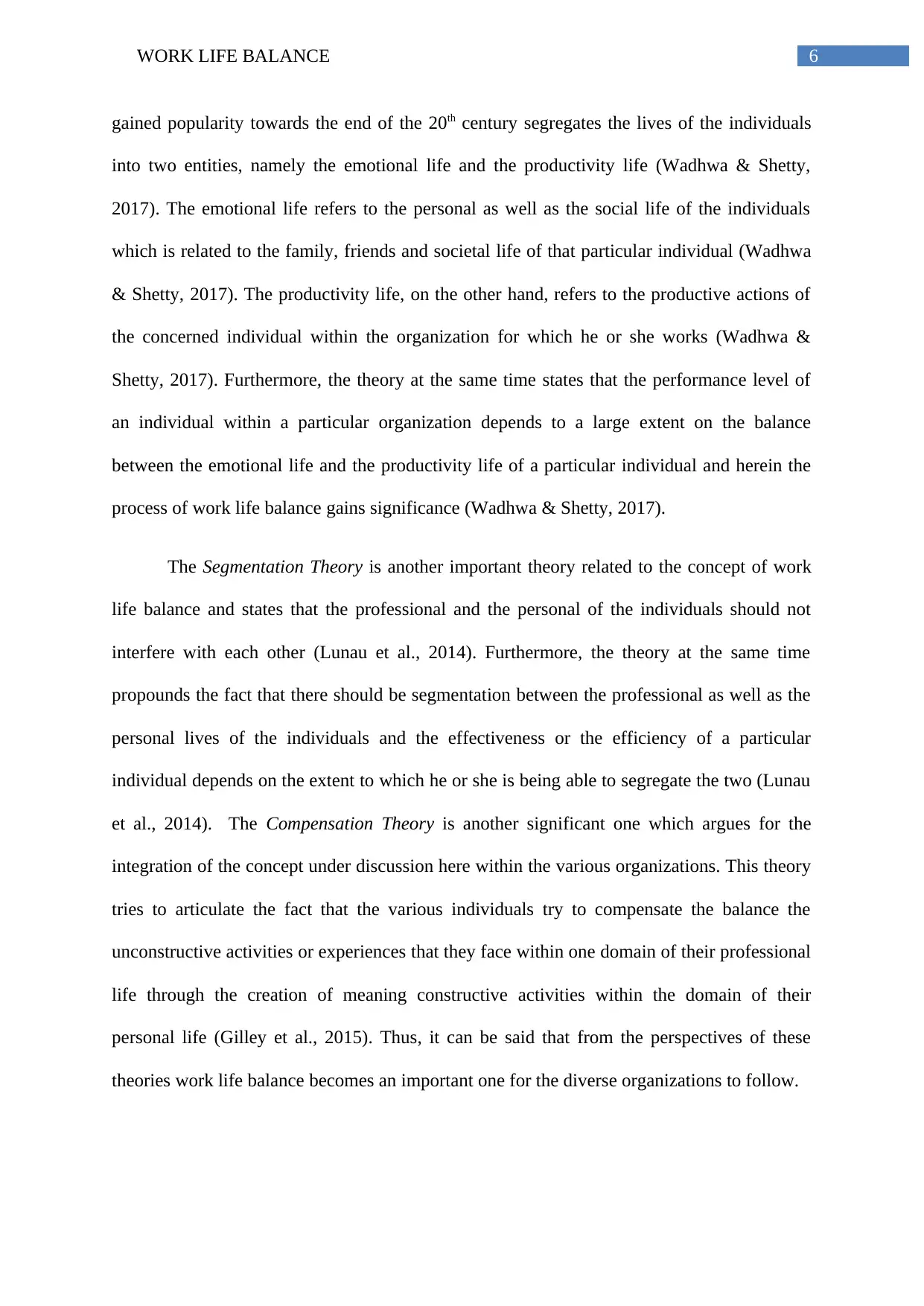
6WORK LIFE BALANCE
gained popularity towards the end of the 20th century segregates the lives of the individuals
into two entities, namely the emotional life and the productivity life (Wadhwa & Shetty,
2017). The emotional life refers to the personal as well as the social life of the individuals
which is related to the family, friends and societal life of that particular individual (Wadhwa
& Shetty, 2017). The productivity life, on the other hand, refers to the productive actions of
the concerned individual within the organization for which he or she works (Wadhwa &
Shetty, 2017). Furthermore, the theory at the same time states that the performance level of
an individual within a particular organization depends to a large extent on the balance
between the emotional life and the productivity life of a particular individual and herein the
process of work life balance gains significance (Wadhwa & Shetty, 2017).
The Segmentation Theory is another important theory related to the concept of work
life balance and states that the professional and the personal of the individuals should not
interfere with each other (Lunau et al., 2014). Furthermore, the theory at the same time
propounds the fact that there should be segmentation between the professional as well as the
personal lives of the individuals and the effectiveness or the efficiency of a particular
individual depends on the extent to which he or she is being able to segregate the two (Lunau
et al., 2014). The Compensation Theory is another significant one which argues for the
integration of the concept under discussion here within the various organizations. This theory
tries to articulate the fact that the various individuals try to compensate the balance the
unconstructive activities or experiences that they face within one domain of their professional
life through the creation of meaning constructive activities within the domain of their
personal life (Gilley et al., 2015). Thus, it can be said that from the perspectives of these
theories work life balance becomes an important one for the diverse organizations to follow.
gained popularity towards the end of the 20th century segregates the lives of the individuals
into two entities, namely the emotional life and the productivity life (Wadhwa & Shetty,
2017). The emotional life refers to the personal as well as the social life of the individuals
which is related to the family, friends and societal life of that particular individual (Wadhwa
& Shetty, 2017). The productivity life, on the other hand, refers to the productive actions of
the concerned individual within the organization for which he or she works (Wadhwa &
Shetty, 2017). Furthermore, the theory at the same time states that the performance level of
an individual within a particular organization depends to a large extent on the balance
between the emotional life and the productivity life of a particular individual and herein the
process of work life balance gains significance (Wadhwa & Shetty, 2017).
The Segmentation Theory is another important theory related to the concept of work
life balance and states that the professional and the personal of the individuals should not
interfere with each other (Lunau et al., 2014). Furthermore, the theory at the same time
propounds the fact that there should be segmentation between the professional as well as the
personal lives of the individuals and the effectiveness or the efficiency of a particular
individual depends on the extent to which he or she is being able to segregate the two (Lunau
et al., 2014). The Compensation Theory is another significant one which argues for the
integration of the concept under discussion here within the various organizations. This theory
tries to articulate the fact that the various individuals try to compensate the balance the
unconstructive activities or experiences that they face within one domain of their professional
life through the creation of meaning constructive activities within the domain of their
personal life (Gilley et al., 2015). Thus, it can be said that from the perspectives of these
theories work life balance becomes an important one for the diverse organizations to follow.
Paraphrase This Document
Need a fresh take? Get an instant paraphrase of this document with our AI Paraphraser
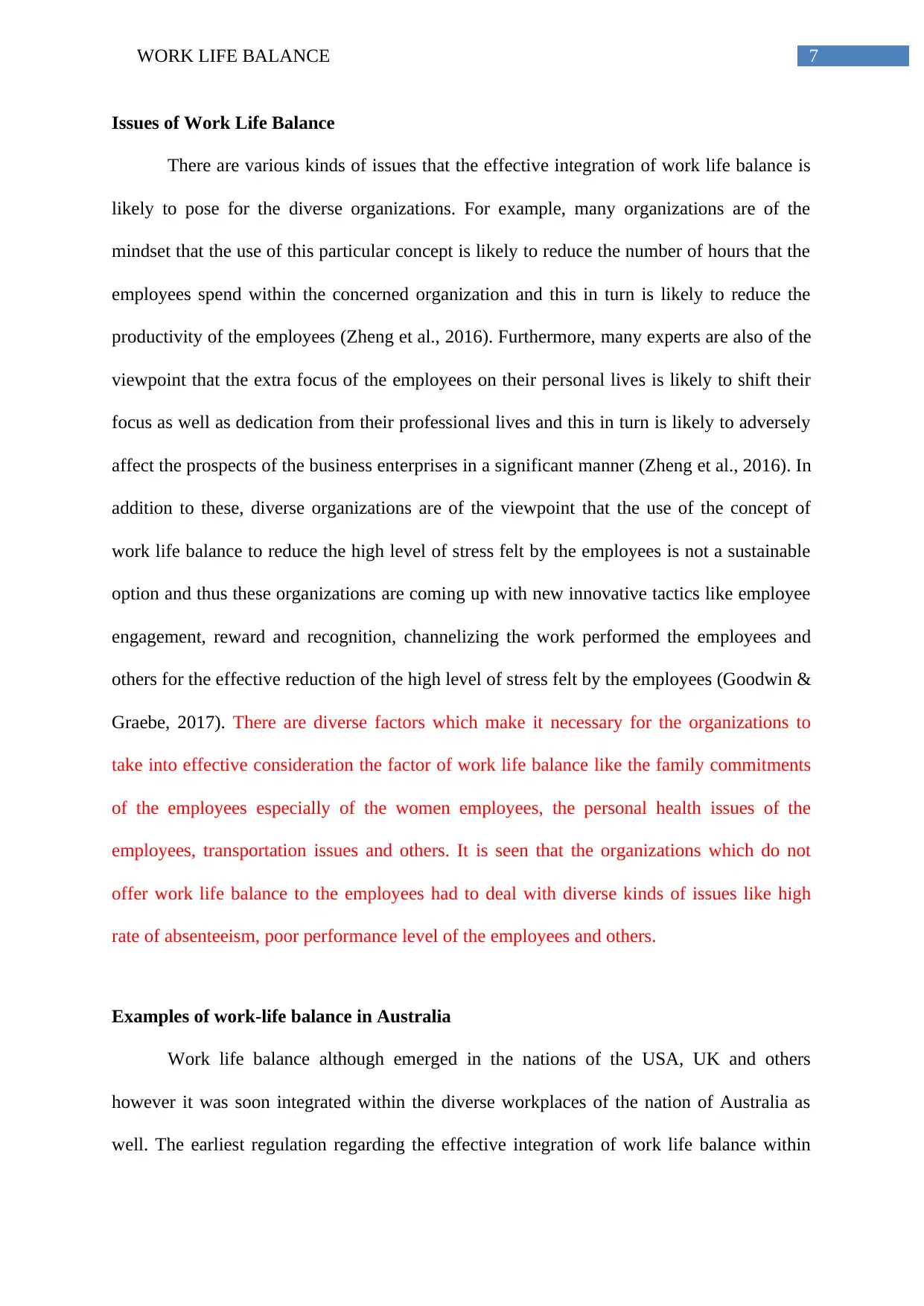
7WORK LIFE BALANCE
Issues of Work Life Balance
There are various kinds of issues that the effective integration of work life balance is
likely to pose for the diverse organizations. For example, many organizations are of the
mindset that the use of this particular concept is likely to reduce the number of hours that the
employees spend within the concerned organization and this in turn is likely to reduce the
productivity of the employees (Zheng et al., 2016). Furthermore, many experts are also of the
viewpoint that the extra focus of the employees on their personal lives is likely to shift their
focus as well as dedication from their professional lives and this in turn is likely to adversely
affect the prospects of the business enterprises in a significant manner (Zheng et al., 2016). In
addition to these, diverse organizations are of the viewpoint that the use of the concept of
work life balance to reduce the high level of stress felt by the employees is not a sustainable
option and thus these organizations are coming up with new innovative tactics like employee
engagement, reward and recognition, channelizing the work performed the employees and
others for the effective reduction of the high level of stress felt by the employees (Goodwin &
Graebe, 2017). There are diverse factors which make it necessary for the organizations to
take into effective consideration the factor of work life balance like the family commitments
of the employees especially of the women employees, the personal health issues of the
employees, transportation issues and others. It is seen that the organizations which do not
offer work life balance to the employees had to deal with diverse kinds of issues like high
rate of absenteeism, poor performance level of the employees and others.
Examples of work-life balance in Australia
Work life balance although emerged in the nations of the USA, UK and others
however it was soon integrated within the diverse workplaces of the nation of Australia as
well. The earliest regulation regarding the effective integration of work life balance within
Issues of Work Life Balance
There are various kinds of issues that the effective integration of work life balance is
likely to pose for the diverse organizations. For example, many organizations are of the
mindset that the use of this particular concept is likely to reduce the number of hours that the
employees spend within the concerned organization and this in turn is likely to reduce the
productivity of the employees (Zheng et al., 2016). Furthermore, many experts are also of the
viewpoint that the extra focus of the employees on their personal lives is likely to shift their
focus as well as dedication from their professional lives and this in turn is likely to adversely
affect the prospects of the business enterprises in a significant manner (Zheng et al., 2016). In
addition to these, diverse organizations are of the viewpoint that the use of the concept of
work life balance to reduce the high level of stress felt by the employees is not a sustainable
option and thus these organizations are coming up with new innovative tactics like employee
engagement, reward and recognition, channelizing the work performed the employees and
others for the effective reduction of the high level of stress felt by the employees (Goodwin &
Graebe, 2017). There are diverse factors which make it necessary for the organizations to
take into effective consideration the factor of work life balance like the family commitments
of the employees especially of the women employees, the personal health issues of the
employees, transportation issues and others. It is seen that the organizations which do not
offer work life balance to the employees had to deal with diverse kinds of issues like high
rate of absenteeism, poor performance level of the employees and others.
Examples of work-life balance in Australia
Work life balance although emerged in the nations of the USA, UK and others
however it was soon integrated within the diverse workplaces of the nation of Australia as
well. The earliest regulation regarding the effective integration of work life balance within
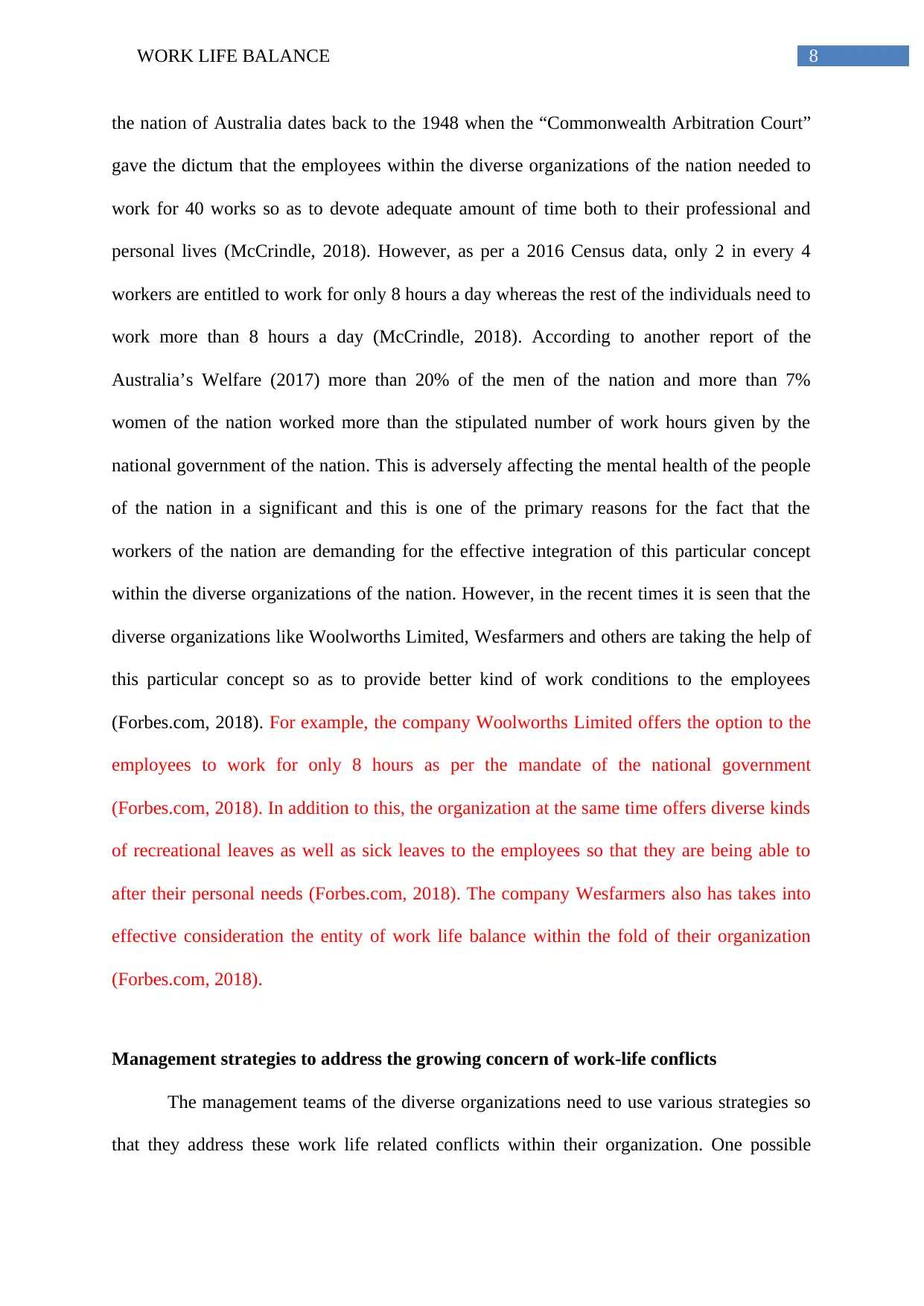
8WORK LIFE BALANCE
the nation of Australia dates back to the 1948 when the “Commonwealth Arbitration Court”
gave the dictum that the employees within the diverse organizations of the nation needed to
work for 40 works so as to devote adequate amount of time both to their professional and
personal lives (McCrindle, 2018). However, as per a 2016 Census data, only 2 in every 4
workers are entitled to work for only 8 hours a day whereas the rest of the individuals need to
work more than 8 hours a day (McCrindle, 2018). According to another report of the
Australia’s Welfare (2017) more than 20% of the men of the nation and more than 7%
women of the nation worked more than the stipulated number of work hours given by the
national government of the nation. This is adversely affecting the mental health of the people
of the nation in a significant and this is one of the primary reasons for the fact that the
workers of the nation are demanding for the effective integration of this particular concept
within the diverse organizations of the nation. However, in the recent times it is seen that the
diverse organizations like Woolworths Limited, Wesfarmers and others are taking the help of
this particular concept so as to provide better kind of work conditions to the employees
(Forbes.com, 2018). For example, the company Woolworths Limited offers the option to the
employees to work for only 8 hours as per the mandate of the national government
(Forbes.com, 2018). In addition to this, the organization at the same time offers diverse kinds
of recreational leaves as well as sick leaves to the employees so that they are being able to
after their personal needs (Forbes.com, 2018). The company Wesfarmers also has takes into
effective consideration the entity of work life balance within the fold of their organization
(Forbes.com, 2018).
Management strategies to address the growing concern of work-life conflicts
The management teams of the diverse organizations need to use various strategies so
that they address these work life related conflicts within their organization. One possible
the nation of Australia dates back to the 1948 when the “Commonwealth Arbitration Court”
gave the dictum that the employees within the diverse organizations of the nation needed to
work for 40 works so as to devote adequate amount of time both to their professional and
personal lives (McCrindle, 2018). However, as per a 2016 Census data, only 2 in every 4
workers are entitled to work for only 8 hours a day whereas the rest of the individuals need to
work more than 8 hours a day (McCrindle, 2018). According to another report of the
Australia’s Welfare (2017) more than 20% of the men of the nation and more than 7%
women of the nation worked more than the stipulated number of work hours given by the
national government of the nation. This is adversely affecting the mental health of the people
of the nation in a significant and this is one of the primary reasons for the fact that the
workers of the nation are demanding for the effective integration of this particular concept
within the diverse organizations of the nation. However, in the recent times it is seen that the
diverse organizations like Woolworths Limited, Wesfarmers and others are taking the help of
this particular concept so as to provide better kind of work conditions to the employees
(Forbes.com, 2018). For example, the company Woolworths Limited offers the option to the
employees to work for only 8 hours as per the mandate of the national government
(Forbes.com, 2018). In addition to this, the organization at the same time offers diverse kinds
of recreational leaves as well as sick leaves to the employees so that they are being able to
after their personal needs (Forbes.com, 2018). The company Wesfarmers also has takes into
effective consideration the entity of work life balance within the fold of their organization
(Forbes.com, 2018).
Management strategies to address the growing concern of work-life conflicts
The management teams of the diverse organizations need to use various strategies so
that they address these work life related conflicts within their organization. One possible
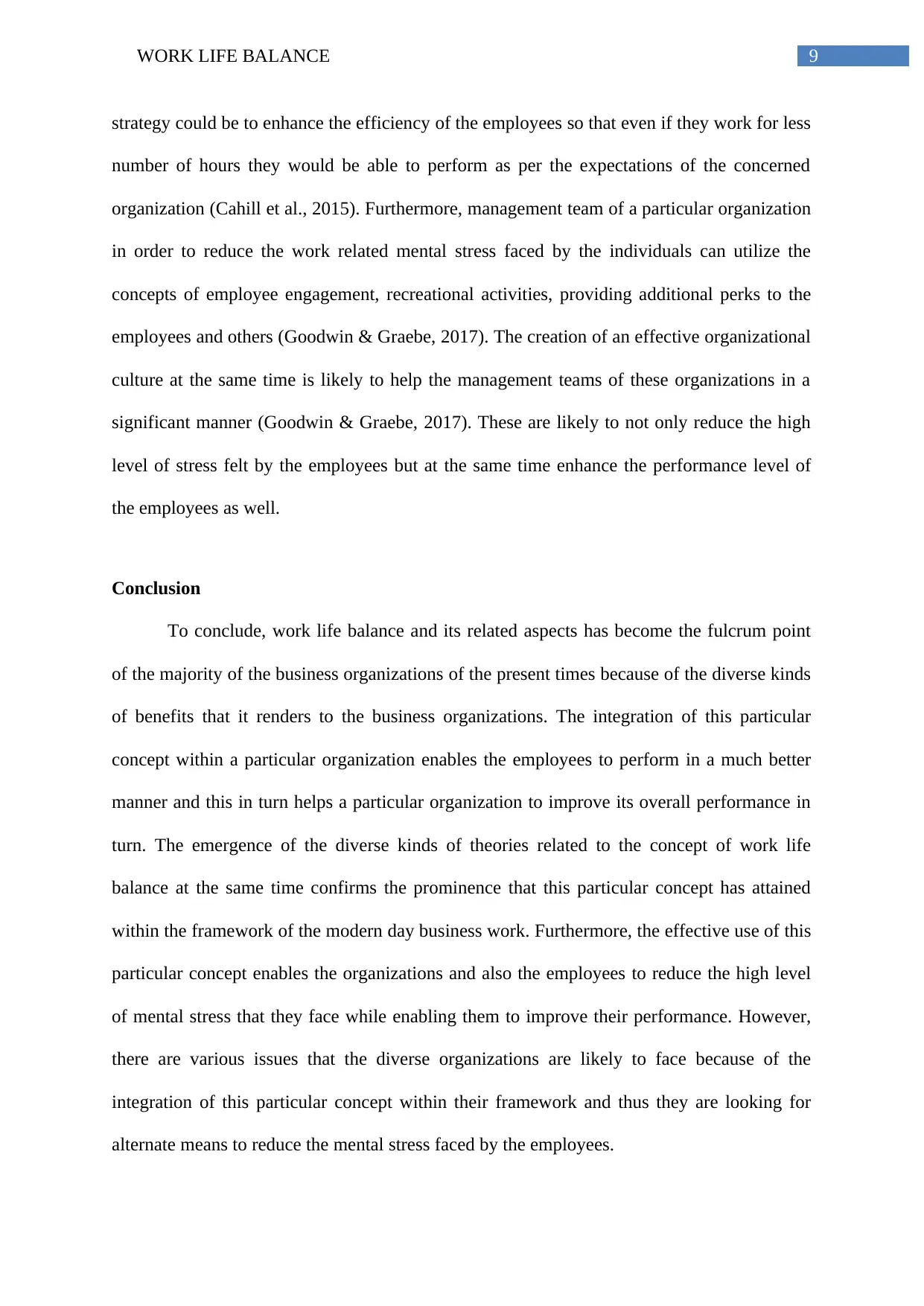
9WORK LIFE BALANCE
strategy could be to enhance the efficiency of the employees so that even if they work for less
number of hours they would be able to perform as per the expectations of the concerned
organization (Cahill et al., 2015). Furthermore, management team of a particular organization
in order to reduce the work related mental stress faced by the individuals can utilize the
concepts of employee engagement, recreational activities, providing additional perks to the
employees and others (Goodwin & Graebe, 2017). The creation of an effective organizational
culture at the same time is likely to help the management teams of these organizations in a
significant manner (Goodwin & Graebe, 2017). These are likely to not only reduce the high
level of stress felt by the employees but at the same time enhance the performance level of
the employees as well.
Conclusion
To conclude, work life balance and its related aspects has become the fulcrum point
of the majority of the business organizations of the present times because of the diverse kinds
of benefits that it renders to the business organizations. The integration of this particular
concept within a particular organization enables the employees to perform in a much better
manner and this in turn helps a particular organization to improve its overall performance in
turn. The emergence of the diverse kinds of theories related to the concept of work life
balance at the same time confirms the prominence that this particular concept has attained
within the framework of the modern day business work. Furthermore, the effective use of this
particular concept enables the organizations and also the employees to reduce the high level
of mental stress that they face while enabling them to improve their performance. However,
there are various issues that the diverse organizations are likely to face because of the
integration of this particular concept within their framework and thus they are looking for
alternate means to reduce the mental stress faced by the employees.
strategy could be to enhance the efficiency of the employees so that even if they work for less
number of hours they would be able to perform as per the expectations of the concerned
organization (Cahill et al., 2015). Furthermore, management team of a particular organization
in order to reduce the work related mental stress faced by the individuals can utilize the
concepts of employee engagement, recreational activities, providing additional perks to the
employees and others (Goodwin & Graebe, 2017). The creation of an effective organizational
culture at the same time is likely to help the management teams of these organizations in a
significant manner (Goodwin & Graebe, 2017). These are likely to not only reduce the high
level of stress felt by the employees but at the same time enhance the performance level of
the employees as well.
Conclusion
To conclude, work life balance and its related aspects has become the fulcrum point
of the majority of the business organizations of the present times because of the diverse kinds
of benefits that it renders to the business organizations. The integration of this particular
concept within a particular organization enables the employees to perform in a much better
manner and this in turn helps a particular organization to improve its overall performance in
turn. The emergence of the diverse kinds of theories related to the concept of work life
balance at the same time confirms the prominence that this particular concept has attained
within the framework of the modern day business work. Furthermore, the effective use of this
particular concept enables the organizations and also the employees to reduce the high level
of mental stress that they face while enabling them to improve their performance. However,
there are various issues that the diverse organizations are likely to face because of the
integration of this particular concept within their framework and thus they are looking for
alternate means to reduce the mental stress faced by the employees.
Secure Best Marks with AI Grader
Need help grading? Try our AI Grader for instant feedback on your assignments.
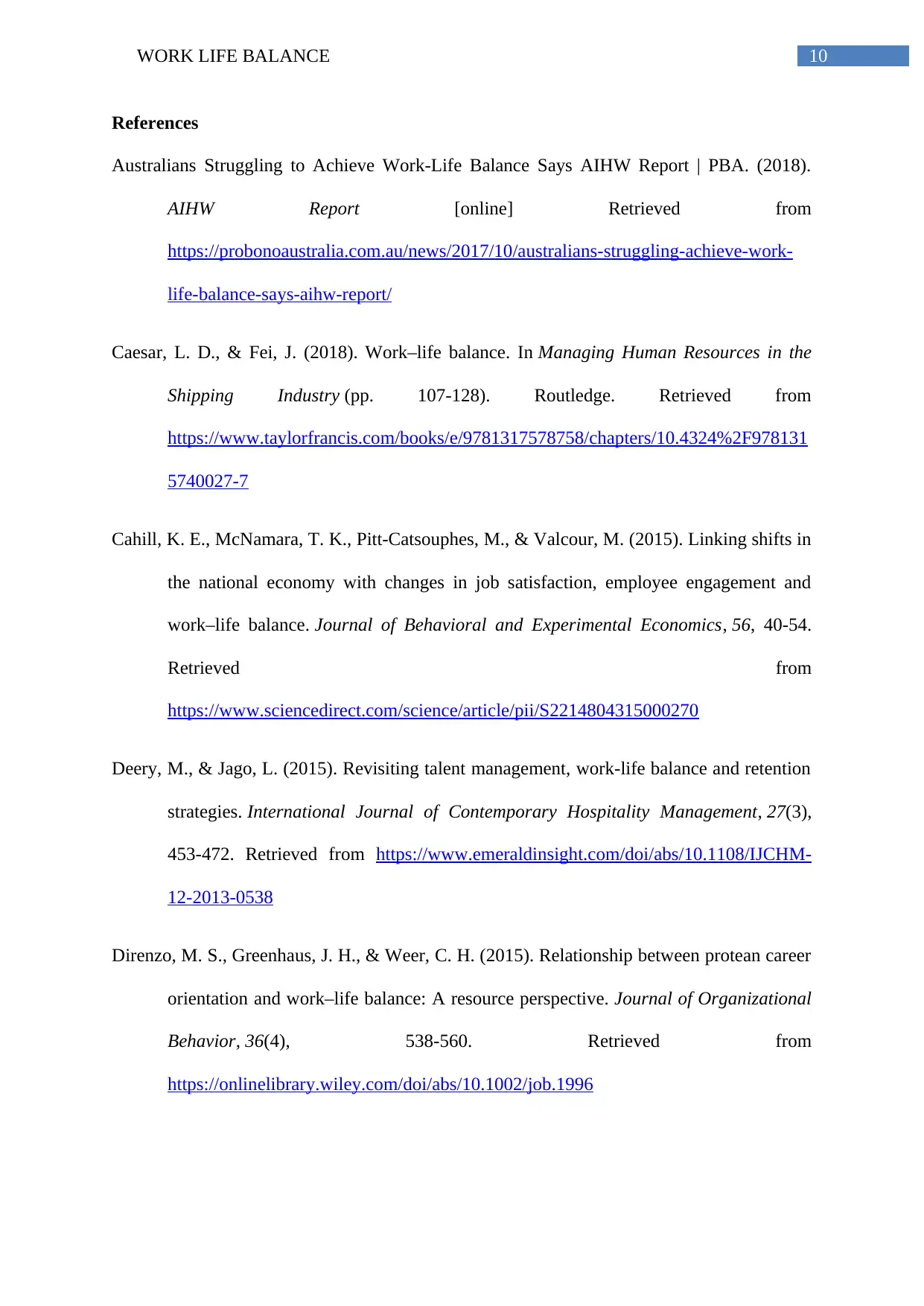
10WORK LIFE BALANCE
References
Australians Struggling to Achieve Work-Life Balance Says AIHW Report | PBA. (2018).
AIHW Report [online] Retrieved from
https://probonoaustralia.com.au/news/2017/10/australians-struggling-achieve-work-
life-balance-says-aihw-report/
Caesar, L. D., & Fei, J. (2018). Work–life balance. In Managing Human Resources in the
Shipping Industry (pp. 107-128). Routledge. Retrieved from
https://www.taylorfrancis.com/books/e/9781317578758/chapters/10.4324%2F978131
5740027-7
Cahill, K. E., McNamara, T. K., Pitt-Catsouphes, M., & Valcour, M. (2015). Linking shifts in
the national economy with changes in job satisfaction, employee engagement and
work–life balance. Journal of Behavioral and Experimental Economics, 56, 40-54.
Retrieved from
https://www.sciencedirect.com/science/article/pii/S2214804315000270
Deery, M., & Jago, L. (2015). Revisiting talent management, work-life balance and retention
strategies. International Journal of Contemporary Hospitality Management, 27(3),
453-472. Retrieved from https://www.emeraldinsight.com/doi/abs/10.1108/IJCHM-
12-2013-0538
Direnzo, M. S., Greenhaus, J. H., & Weer, C. H. (2015). Relationship between protean career
orientation and work–life balance: A resource perspective. Journal of Organizational
Behavior, 36(4), 538-560. Retrieved from
https://onlinelibrary.wiley.com/doi/abs/10.1002/job.1996
References
Australians Struggling to Achieve Work-Life Balance Says AIHW Report | PBA. (2018).
AIHW Report [online] Retrieved from
https://probonoaustralia.com.au/news/2017/10/australians-struggling-achieve-work-
life-balance-says-aihw-report/
Caesar, L. D., & Fei, J. (2018). Work–life balance. In Managing Human Resources in the
Shipping Industry (pp. 107-128). Routledge. Retrieved from
https://www.taylorfrancis.com/books/e/9781317578758/chapters/10.4324%2F978131
5740027-7
Cahill, K. E., McNamara, T. K., Pitt-Catsouphes, M., & Valcour, M. (2015). Linking shifts in
the national economy with changes in job satisfaction, employee engagement and
work–life balance. Journal of Behavioral and Experimental Economics, 56, 40-54.
Retrieved from
https://www.sciencedirect.com/science/article/pii/S2214804315000270
Deery, M., & Jago, L. (2015). Revisiting talent management, work-life balance and retention
strategies. International Journal of Contemporary Hospitality Management, 27(3),
453-472. Retrieved from https://www.emeraldinsight.com/doi/abs/10.1108/IJCHM-
12-2013-0538
Direnzo, M. S., Greenhaus, J. H., & Weer, C. H. (2015). Relationship between protean career
orientation and work–life balance: A resource perspective. Journal of Organizational
Behavior, 36(4), 538-560. Retrieved from
https://onlinelibrary.wiley.com/doi/abs/10.1002/job.1996
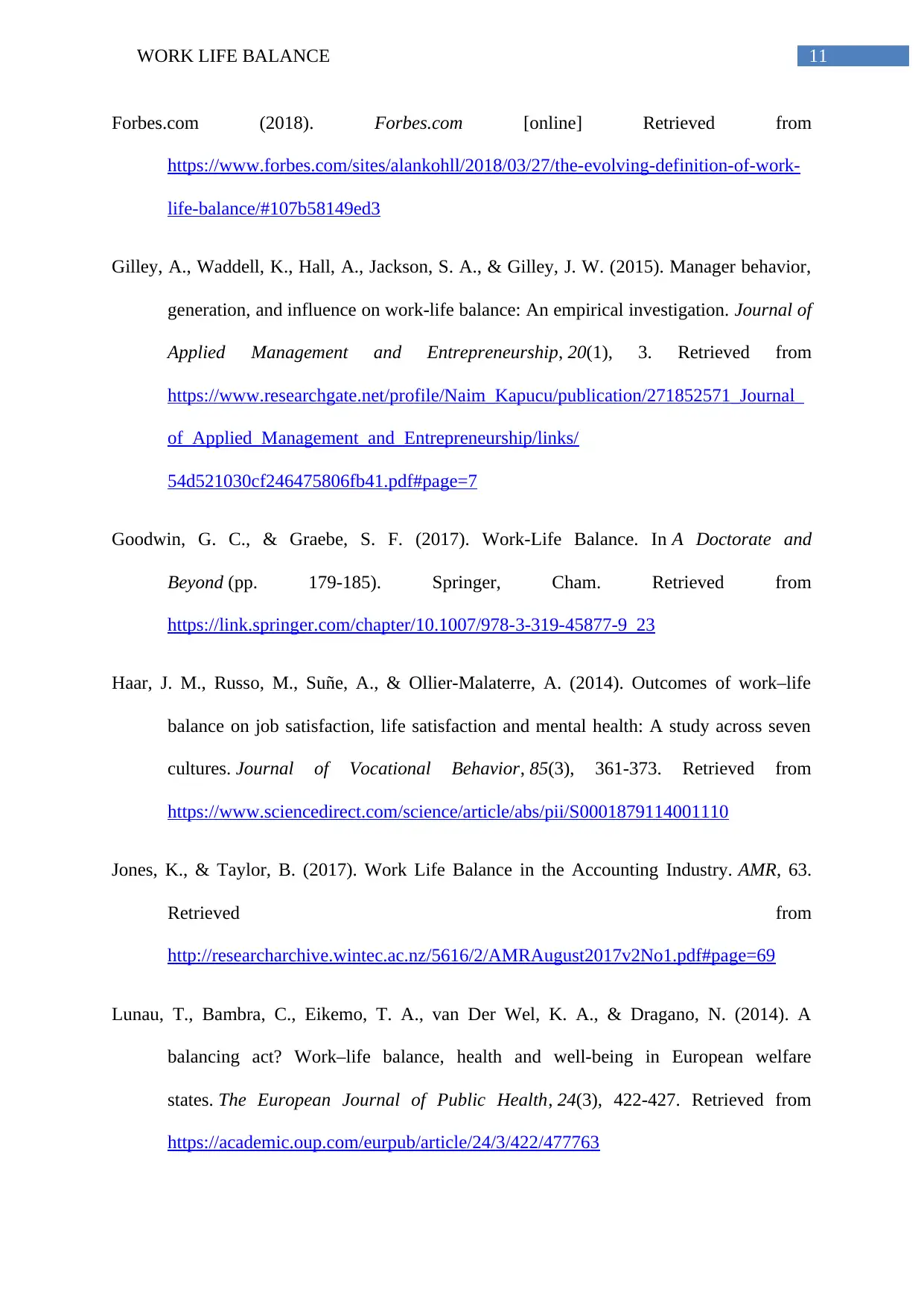
11WORK LIFE BALANCE
Forbes.com (2018). Forbes.com [online] Retrieved from
https://www.forbes.com/sites/alankohll/2018/03/27/the-evolving-definition-of-work-
life-balance/#107b58149ed3
Gilley, A., Waddell, K., Hall, A., Jackson, S. A., & Gilley, J. W. (2015). Manager behavior,
generation, and influence on work-life balance: An empirical investigation. Journal of
Applied Management and Entrepreneurship, 20(1), 3. Retrieved from
https://www.researchgate.net/profile/Naim_Kapucu/publication/271852571_Journal_
of_Applied_Management_and_Entrepreneurship/links/
54d521030cf246475806fb41.pdf#page=7
Goodwin, G. C., & Graebe, S. F. (2017). Work-Life Balance. In A Doctorate and
Beyond (pp. 179-185). Springer, Cham. Retrieved from
https://link.springer.com/chapter/10.1007/978-3-319-45877-9_23
Haar, J. M., Russo, M., Suñe, A., & Ollier-Malaterre, A. (2014). Outcomes of work–life
balance on job satisfaction, life satisfaction and mental health: A study across seven
cultures. Journal of Vocational Behavior, 85(3), 361-373. Retrieved from
https://www.sciencedirect.com/science/article/abs/pii/S0001879114001110
Jones, K., & Taylor, B. (2017). Work Life Balance in the Accounting Industry. AMR, 63.
Retrieved from
http://researcharchive.wintec.ac.nz/5616/2/AMRAugust2017v2No1.pdf#page=69
Lunau, T., Bambra, C., Eikemo, T. A., van Der Wel, K. A., & Dragano, N. (2014). A
balancing act? Work–life balance, health and well-being in European welfare
states. The European Journal of Public Health, 24(3), 422-427. Retrieved from
https://academic.oup.com/eurpub/article/24/3/422/477763
Forbes.com (2018). Forbes.com [online] Retrieved from
https://www.forbes.com/sites/alankohll/2018/03/27/the-evolving-definition-of-work-
life-balance/#107b58149ed3
Gilley, A., Waddell, K., Hall, A., Jackson, S. A., & Gilley, J. W. (2015). Manager behavior,
generation, and influence on work-life balance: An empirical investigation. Journal of
Applied Management and Entrepreneurship, 20(1), 3. Retrieved from
https://www.researchgate.net/profile/Naim_Kapucu/publication/271852571_Journal_
of_Applied_Management_and_Entrepreneurship/links/
54d521030cf246475806fb41.pdf#page=7
Goodwin, G. C., & Graebe, S. F. (2017). Work-Life Balance. In A Doctorate and
Beyond (pp. 179-185). Springer, Cham. Retrieved from
https://link.springer.com/chapter/10.1007/978-3-319-45877-9_23
Haar, J. M., Russo, M., Suñe, A., & Ollier-Malaterre, A. (2014). Outcomes of work–life
balance on job satisfaction, life satisfaction and mental health: A study across seven
cultures. Journal of Vocational Behavior, 85(3), 361-373. Retrieved from
https://www.sciencedirect.com/science/article/abs/pii/S0001879114001110
Jones, K., & Taylor, B. (2017). Work Life Balance in the Accounting Industry. AMR, 63.
Retrieved from
http://researcharchive.wintec.ac.nz/5616/2/AMRAugust2017v2No1.pdf#page=69
Lunau, T., Bambra, C., Eikemo, T. A., van Der Wel, K. A., & Dragano, N. (2014). A
balancing act? Work–life balance, health and well-being in European welfare
states. The European Journal of Public Health, 24(3), 422-427. Retrieved from
https://academic.oup.com/eurpub/article/24/3/422/477763
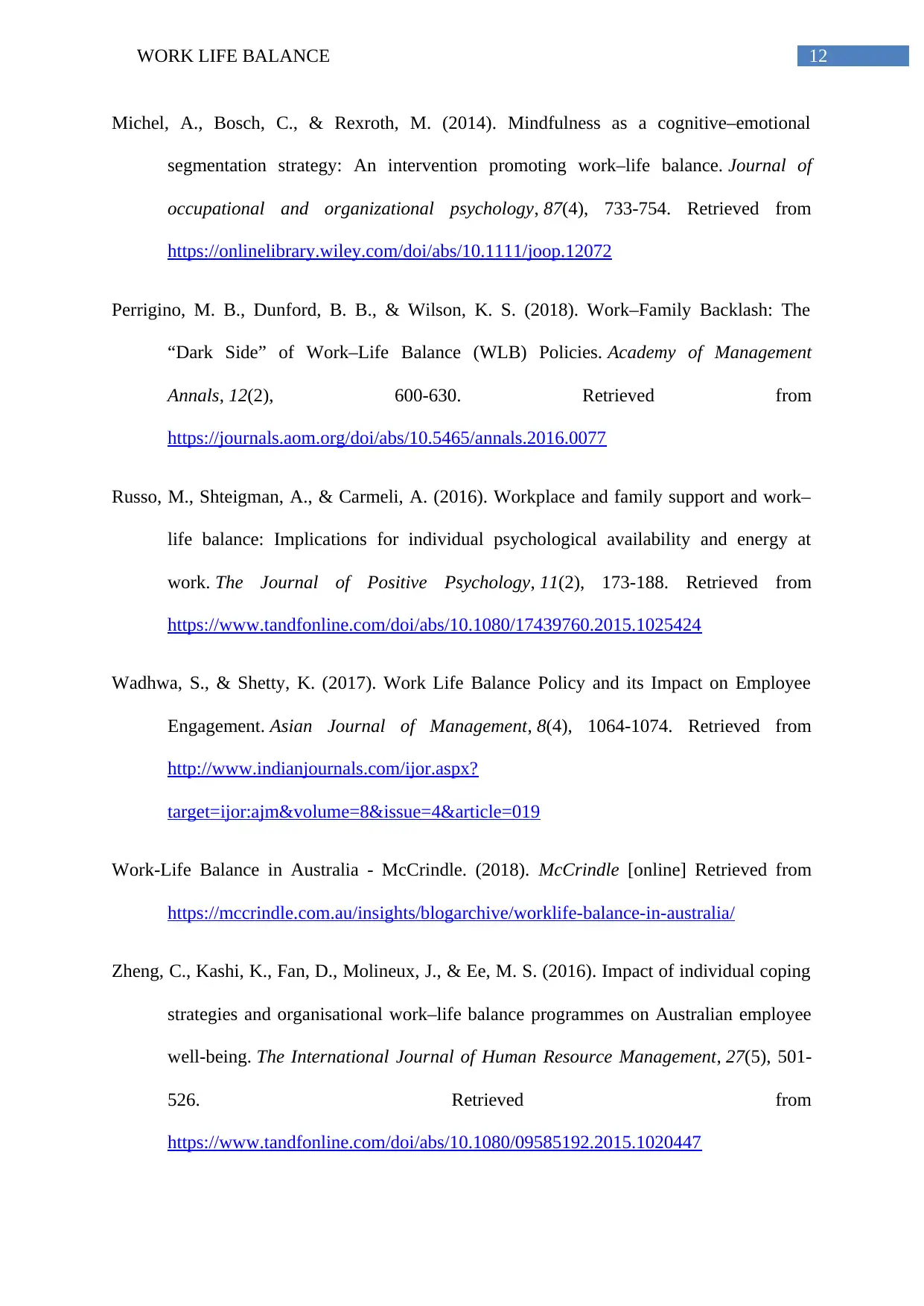
12WORK LIFE BALANCE
Michel, A., Bosch, C., & Rexroth, M. (2014). Mindfulness as a cognitive–emotional
segmentation strategy: An intervention promoting work–life balance. Journal of
occupational and organizational psychology, 87(4), 733-754. Retrieved from
https://onlinelibrary.wiley.com/doi/abs/10.1111/joop.12072
Perrigino, M. B., Dunford, B. B., & Wilson, K. S. (2018). Work–Family Backlash: The
“Dark Side” of Work–Life Balance (WLB) Policies. Academy of Management
Annals, 12(2), 600-630. Retrieved from
https://journals.aom.org/doi/abs/10.5465/annals.2016.0077
Russo, M., Shteigman, A., & Carmeli, A. (2016). Workplace and family support and work–
life balance: Implications for individual psychological availability and energy at
work. The Journal of Positive Psychology, 11(2), 173-188. Retrieved from
https://www.tandfonline.com/doi/abs/10.1080/17439760.2015.1025424
Wadhwa, S., & Shetty, K. (2017). Work Life Balance Policy and its Impact on Employee
Engagement. Asian Journal of Management, 8(4), 1064-1074. Retrieved from
http://www.indianjournals.com/ijor.aspx?
target=ijor:ajm&volume=8&issue=4&article=019
Work-Life Balance in Australia - McCrindle. (2018). McCrindle [online] Retrieved from
https://mccrindle.com.au/insights/blogarchive/worklife-balance-in-australia/
Zheng, C., Kashi, K., Fan, D., Molineux, J., & Ee, M. S. (2016). Impact of individual coping
strategies and organisational work–life balance programmes on Australian employee
well-being. The International Journal of Human Resource Management, 27(5), 501-
526. Retrieved from
https://www.tandfonline.com/doi/abs/10.1080/09585192.2015.1020447
Michel, A., Bosch, C., & Rexroth, M. (2014). Mindfulness as a cognitive–emotional
segmentation strategy: An intervention promoting work–life balance. Journal of
occupational and organizational psychology, 87(4), 733-754. Retrieved from
https://onlinelibrary.wiley.com/doi/abs/10.1111/joop.12072
Perrigino, M. B., Dunford, B. B., & Wilson, K. S. (2018). Work–Family Backlash: The
“Dark Side” of Work–Life Balance (WLB) Policies. Academy of Management
Annals, 12(2), 600-630. Retrieved from
https://journals.aom.org/doi/abs/10.5465/annals.2016.0077
Russo, M., Shteigman, A., & Carmeli, A. (2016). Workplace and family support and work–
life balance: Implications for individual psychological availability and energy at
work. The Journal of Positive Psychology, 11(2), 173-188. Retrieved from
https://www.tandfonline.com/doi/abs/10.1080/17439760.2015.1025424
Wadhwa, S., & Shetty, K. (2017). Work Life Balance Policy and its Impact on Employee
Engagement. Asian Journal of Management, 8(4), 1064-1074. Retrieved from
http://www.indianjournals.com/ijor.aspx?
target=ijor:ajm&volume=8&issue=4&article=019
Work-Life Balance in Australia - McCrindle. (2018). McCrindle [online] Retrieved from
https://mccrindle.com.au/insights/blogarchive/worklife-balance-in-australia/
Zheng, C., Kashi, K., Fan, D., Molineux, J., & Ee, M. S. (2016). Impact of individual coping
strategies and organisational work–life balance programmes on Australian employee
well-being. The International Journal of Human Resource Management, 27(5), 501-
526. Retrieved from
https://www.tandfonline.com/doi/abs/10.1080/09585192.2015.1020447
Paraphrase This Document
Need a fresh take? Get an instant paraphrase of this document with our AI Paraphraser
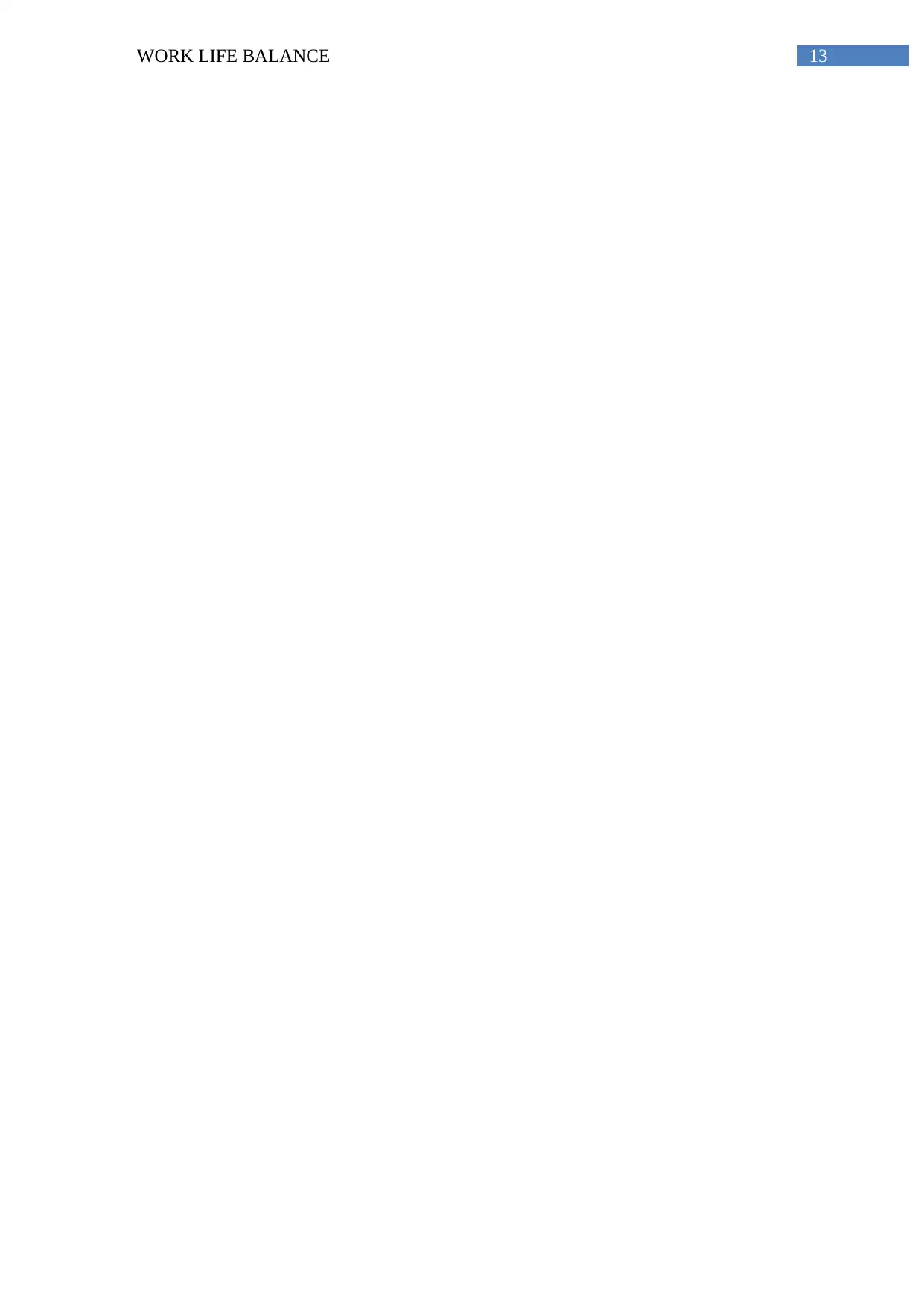
13WORK LIFE BALANCE
1 out of 14
Related Documents
Your All-in-One AI-Powered Toolkit for Academic Success.
+13062052269
info@desklib.com
Available 24*7 on WhatsApp / Email
![[object Object]](/_next/static/media/star-bottom.7253800d.svg)
Unlock your academic potential
© 2024 | Zucol Services PVT LTD | All rights reserved.




